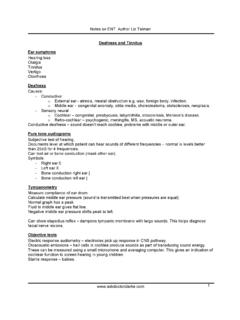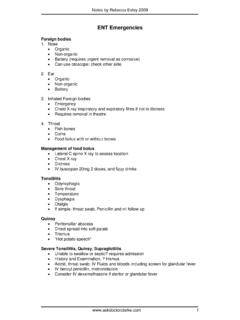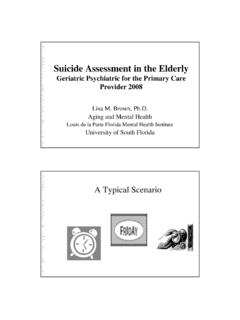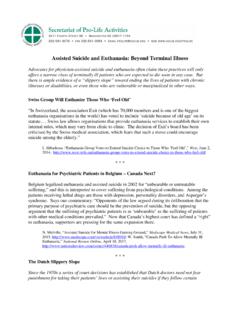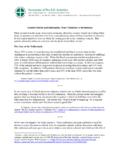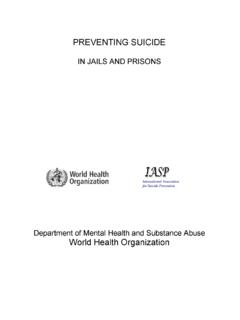Transcription of Depressive disorder - Ask Doctor Clarke
1 Depressive disorder Definition Depression is a major psychiatric illness characterised by 3 main symptoms namely Low mood Loss of interest / loss of ability to experience pleasure (anhedonia). Excessive tiredness Other accessory symptoms commonly found in depression include, disturbance in sleep, disturbance in appetite, impaired concentration, loss of libido, constipation, loss of self- esteem, suicidal ideation and distortions in thinking leading to cognitive distortions. Depressed mood as a symptom is common in everyday life and does not in itself constitute Depressive disorder . The above symptoms usually need to be present for a minimum of two weeks before Depressive disorder can be diagnosed. Epidemiology The annual incidence rate of Depressive disorder is The life time prevalence is It is more common in women than men and in lower social classes than higher ones. Aetiology The causes of Depressive disorder can be classified into biological and psychosocial factors.
2 Biological Physical illnesses hypothyroidism, diabetes, cushings syndrome, carcinoma of head of pancreas and other tumours, strokes especially if left sided, MI. Infections viral infections (such as influenza). Drugs calcium channel blockers, some antihypertensives, alcohol, cocaine Psychosocial Life events marriage , divorce, moving house, examinations etc. Case History Mrs B was a 35 year old secretary who presented to her general practitioner feeling low. She had recently been humiliated by her boss in a business meeting and felt she could no longer carry on going to On enquiry she admitted that she had felt low for the last three weeks and was waking up very early in the mornings, finding it impossible to get back to sleep. She had lost weight as she was not eating properly and dreaded going to work each day. She confessed to having thoughts of killing herself but said she had no plans to do so.
3 She also wanted some iron tablets as she was convinced she was anaemic stating I feel so tired and weak'. Dr C Olojugba 2005 1. Mental State Examination The presentation of depression can vary between patients but some features on mental state examination tend to be consistent in severely depressed patients. Appearance and behaviour: Stooped posturing, depressed facial expression with down turned corners of mouth, reduced spontaneous movement, poor eye contact, sometimes tearfulness. Speech: reduced rate, volume and tone. Lack of spontaneity but coherent . Mood: Low mood, often with disturbed sleep and appetite Thoughts: Depressive content ( includng hopelessness, worthlessness, helplessness) , suicidal ideation, reduced flow of ideas, delusions may occur nihilistic delusions ,delusions of guilt . Perception : reduced intensity of normal perceptions. Occasionally auditory hallucinations Cognitions: impaired concentration is common Insight: Preserved insight into illness.
4 Case History: Mental State Examination On mental state examination she presented as a casually-dressed Caucasian woman, of average height and slim build. Her hair was untidy and she wore no make-up. She had a sad facial expression, which did not change during the interview. She sat on her chair for the entire time, moving very little and staring at her hands. Her speech was coherent and relevant but she spoke quietly and slowly. She said her mood was 2 out of 10 and objectively she looked depressed in affect. There was no evidence of delusional thinking but she was morbid in her thought content, repeatedly stating I am such a failure'. There was no evidence of hallucinosis but it was evident hat her concentration was poor. She did admit to feeling depressed and was willing to accept treatment. Differential diagnosis It is important to recognise that Depressive disorder can in itself be a symptom' of physical illness hence the most important differential is that of an underlying medical illness.
5 Examples are stated above. With this in mind anyone who presents with Depressive disorder should routinely have a full physical examination as well as investigations, which should include. Full Blood Count, Urea & Electrolytes, Liver Function Tests and Thyroid Function Tests. Dr C Olojugba 2005 2. Treatment of Depressive disorder The treatment of depression requires a bio psychosocial approach. This usually involves both medication and psychological treatments. Drugs for depression Selective serotonin reuptake inhibitors- 1st line antidepressants because less side effects and safer in overdose . Well tolerated. fluoextine ( prozac) citalopram, paroxetine, sertraline, fluvoxamine. Side effects include agitation (hence not given at night), nausea and GI upset sexual dysfunction Tricyclic antidepressants Amitryptiline, dothiepin clomipramine. Classed as sedating and non sedating. Not used as frequently given toxicity in overdose.
6 Anitcholinergic properties responsible for side effects of dry mouth, postural hypotesion , blurred vision, urinary retention, constipation and confusion. Monoamine oxidase inhibitors: Phenelzine, in atypical depression with reversed vegetative symptoms increased appetitie and increased sleep. Strict diet as can cause hypertensive crisis (Cheese reaction) in diets with high tyramine content well hung game and certain cheeses. Nor adrenaline and serotonin reuptake inhibitors: venlafaxine. These drugs provide increased seroternergic and adrenergic neurotransmission. Side effects relate to which ever action is most prominent venlafaxine at low doses has more of a serotonergic effect leading to GI upset and nausea but at higher doses there is more of an adrenergic effect leading to hypertension Noradrenaline reuptake inhibitorse : reboxitine .This increases adrenergic neurotransmission and may be useful for patients who have tiredness as a predominant symptom Lithium : This is used in psychiatry as a mood stabilizer.
7 Used in combination with antidepressants to improve response. Also useful in prophylaxis in bipolar depression. U&Es and thyroid function and ECG need to be done before prescribing. Electroconvulsive therapy Used in severe depression, it involves the passage of electricity through the brain. It is very effective and safe. Side-effects include that of anaesthetic and transient amnesia. 6-8. treatment sessions are usually needed in each Depressive episode. Other physical treatments: Sleep deprivation, Light boxes, transcranial magnetic stimulation. Psychosocial Treatments Cognitive behavioural therapy: Structured form of therapy. Involves identifying and challenging negative thoughts that perpetuate depression. Involves home work assignments and behavioural strategies problem solving skills training. Family Therapy: Therapy is in a family setting. Dysfunctional methods of relating are identified and modified to more useful ones.
8 Dr C Olojugba 2005 3. Interpersonal Therapy: Involves focusing on specific relationship difficulties with specific people and working through them on a practical level Supportive Counselling Non-structured therapy. No changes to thinking or behaviour are made. The patient is merely listened to and their difficulties acknowledged. Case history: management Her diagnosed Mrs B as suffering from Depressive disorder He did a risk assessment (see below) and categorised her risk of suicide in the short term as low- moderate. He arranged for her to have routine blood investigations done and started her on an antidepressant. He chose an SSRI because of its low side effect profile and tolerability. He advised Mrs B to take it every morning and to expect results in around 4 weeks. He arranged to see her again in a week's time and referred her to the practice counsellor for supportive counselling.
9 She responded well to this regime. Risk Assessment of the Depressed Patient Risk is categorised into three main themes 1. Risk of self-harm or suicide 2. Risk of violence or homicide ( not discussed here). 3. Risk of self-neglect (not discussed here). Risk of self-harm or suicide Epidemiologicallly the following factors have been shown to be more common in people who have self harmed or committed suicide. These factors need to be taken into account when risk assessing any patient that presents with depression Depression raises the risk of suicide Any other psychiatric illness increases the risk Drug and alcohol abuse increases risk Chronic physical illness increases risk Men are more at risk of suicide Suicide is more common in elderly people and men over 40years Single people are more at risk than married people Unemployment increases risk History of previous attempts at self harm increased the risk of suicide A family history of suicide increases the risk of suicide Important note: Enquiring about suicidal ideation at interview does not increase the risk of suicide.
10 In the end, it is impossible to predict accurately everyone who will commit suicide but by using the above criteria to quantify risk it is possible to reduce the numbers that do. It is also important to remember that risk assessment is only one side of the coin when it comes to reducing suicide rates. Risk management should be he next step guided by the risk assessment. Dr C Olojugba 2005 4. EXAMPLE OCSE. Mrs B is a 35 year old secretary presenting to you complaining of feeling low. Assess her mood. Marking Scheme Introduces self to patient and puts patient at ease Elicits presenting complaint Elicits features of depression 1. Low mood 2. Tiredness 3. Anhedonia 4. Sleep 5. Appetite Enquires about past psychiatric history Enquires about relevant medical history thyroid disease Enquires about delusions Enquires about alcohol use Enquires about suicidal ideation Conducts the interview in a professional manner Dr Charles Olojugba 2005.
